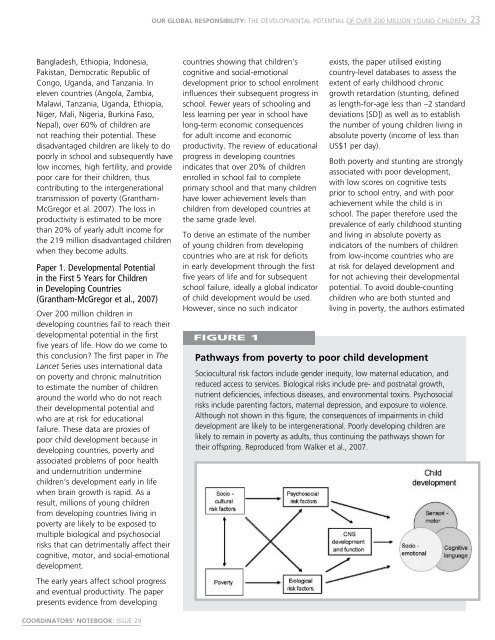A global call to action for early childhood
A global call to action for early childhood
A global call to action for early childhood
Create successful ePaper yourself
Turn your PDF publications into a flip-book with our unique Google optimized e-Paper software.
Our <strong>global</strong> responsibility: The developmental potential of over 200 million young children<br />
23<br />
Bangladesh, Ethiopia, Indonesia,<br />
Pakistan, Democratic Republic of<br />
Congo, Uganda, and Tanzania. In<br />
eleven countries (Angola, Zambia,<br />
Malawi, Tanzania, Uganda, Ethiopia,<br />
Niger, Mali, Nigeria, Burkina Faso,<br />
Nepal), over 60% of children are<br />
not reaching their potential. These<br />
disadvantaged children are likely <strong>to</strong> do<br />
poorly in school and subsequently have<br />
low incomes, high fertility, and provide<br />
poor care <strong>for</strong> their children, thus<br />
contributing <strong>to</strong> the intergenerational<br />
transmission of poverty (Grantham-<br />
McGregor et al. 2007). The loss in<br />
productivity is estimated <strong>to</strong> be more<br />
than 20% of y<strong>early</strong> adult income <strong>for</strong><br />
the 219 million disadvantaged children<br />
when they become adults.<br />
Paper 1. Developmental Potential<br />
in the First 5 Years <strong>for</strong> Children<br />
in Developing Countries<br />
(Grantham-McGregor et al., 2007)<br />
Over 200 million children in<br />
developing countries fail <strong>to</strong> reach their<br />
developmental potential in the first<br />
five years of life. How do we come <strong>to</strong><br />
this conclusion? The first paper in The<br />
Lancet Series uses international data<br />
on poverty and chronic malnutrition<br />
<strong>to</strong> estimate the number of children<br />
around the world who do not reach<br />
their developmental potential and<br />
who are at risk <strong>for</strong> educational<br />
failure. These data are proxies of<br />
poor child development because in<br />
developing countries, poverty and<br />
associated problems of poor health<br />
and undernutrition undermine<br />
children’s development <strong>early</strong> in life<br />
when brain growth is rapid. As a<br />
result, millions of young children<br />
from developing countries living in<br />
poverty are likely <strong>to</strong> be exposed <strong>to</strong><br />
multiple biological and psychosocial<br />
risks that can detrimentally affect their<br />
cognitive, mo<strong>to</strong>r, and social-emotional<br />
development.<br />
The <strong>early</strong> years affect school progress<br />
and eventual productivity. The paper<br />
presents evidence from developing<br />
countries showing that children’s<br />
cognitive and social-emotional<br />
development prior <strong>to</strong> school enrolment<br />
influences their subsequent progress in<br />
school. Fewer years of schooling and<br />
less learning per year in school have<br />
long-term economic consequences<br />
<strong>for</strong> adult income and economic<br />
productivity. The review of educational<br />
progress in developing countries<br />
indicates that over 20% of children<br />
enrolled in school fail <strong>to</strong> complete<br />
primary school and that many children<br />
have lower achievement levels than<br />
children from developed countries at<br />
the same grade level.<br />
To derive an estimate of the number<br />
of young children from developing<br />
countries who are at risk <strong>for</strong> deficits<br />
in <strong>early</strong> development through the first<br />
five years of life and <strong>for</strong> subsequent<br />
school failure, ideally a <strong>global</strong> indica<strong>to</strong>r<br />
of child development would be used.<br />
However, since no such indica<strong>to</strong>r<br />
figure 1<br />
exists, the paper utilised existing<br />
country-level databases <strong>to</strong> assess the<br />
extent of <strong>early</strong> <strong>childhood</strong> chronic<br />
growth retardation (stunting, defined<br />
as length-<strong>for</strong>-age less than –2 standard<br />
deviations [SD]) as well as <strong>to</strong> establish<br />
the number of young children living in<br />
absolute poverty (income of less than<br />
US$1 per day).<br />
Both poverty and stunting are strongly<br />
associated with poor development,<br />
with low scores on cognitive tests<br />
prior <strong>to</strong> school entry, and with poor<br />
achievement while the child is in<br />
school. The paper there<strong>for</strong>e used the<br />
prevalence of <strong>early</strong> <strong>childhood</strong> stunting<br />
and living in absolute poverty as<br />
indica<strong>to</strong>rs of the numbers of children<br />
from low-income countries who are<br />
at risk <strong>for</strong> delayed development and<br />
<strong>for</strong> not achieving their developmental<br />
potential. To avoid double-counting<br />
children who are both stunted and<br />
living in poverty, the authors estimated<br />
Pathways from poverty <strong>to</strong> poor child development<br />
Sociocultural risk fac<strong>to</strong>rs include gender inequity, low maternal education, and<br />
reduced access <strong>to</strong> services. Biological risks include pre- and postnatal growth,<br />
nutrient deficiencies, infectious diseases, and environmental <strong>to</strong>xins. Psychosocial<br />
risks include parenting fac<strong>to</strong>rs, maternal depression, and exposure <strong>to</strong> violence.<br />
Although not shown in this figure, the consequences of impairments in child<br />
development are likely <strong>to</strong> be intergenerational. Poorly developing children are<br />
likely <strong>to</strong> remain in poverty as adults, thus continuing the pathways shown <strong>for</strong><br />
their offspring. Reproduced from Walker et al., 2007.<br />
COORDINATORS’ NOTEBOOK: ISSUE 29
















